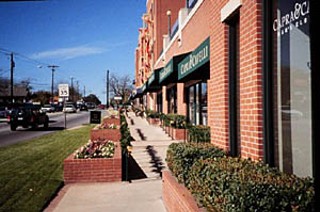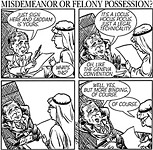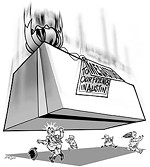Naked City
Building Better Big Boxes
By Amy Smith, Fri., March 5, 2004

Austin has a lot of things it can be proud of, but the look of Anywhere, USA, is not one of them. Who knew, for example, that a Wal-Mart doesn't have to look like a Wal-Mart if the city's design standards dictate otherwise?
But Austin's rules and regs on aesthetics, we learned at last week's council meeting, fall well below the standards set by neighboring cities, let alone the rest of the country. In view of that shortcoming, the council has instructed city staff to spend the next month or so developing a set of design standards for new commercial and retail developments around town. It helps that the Real Estate Council of Austin has climbed aboard this issue, despite some moaning by some of its membership.
Council Member Brewster McCracken first raised the issue of design standards during last year's protracted debate over the invasion of national big-box chains and their impact on neighborhoods and local businesses. So the city embarked on two separate but intrinsically related endeavors: one that would assess the economic and environmental effects of big boxes, the other leading to upgraded requirements for how they should look and function.
On the former, a study led by economist John Hockenyos is well under way. Since retail chains are a fact of life, Scott Polikov, a town planner and consultant on the study team, is taking a big-picture, policy-oriented approach to figuring out how to integrate local businesses into developments anchored by major chains. "National retailers have the income and balance sheet to get loans," he said, "but small local businesses often don't have the wherewithal to get credit to expand their businesses." That's where the city could come into play, he added, to provide support for these small start-up businesses. Another facet of the study that could provide interesting findings, Polikov said, will be a focus group involving local retailers.
On the second component of the city's big-box response, McCracken last week led the council through a PowerPoint presentation that cited example after example of how Austin falls short on aesthetics. "This is a Target here in South Austin," he said. "And you'll notice that it has no windows or design articulation." In other places, though, he noted, Target "is doing multistory buildings, stores with unique urban designs all over the country."
Closer to home, the small west side municipality of Rollingwood put Albertsons through the wringer to force the supermarket chain to adhere to its design standards. The end result, McCracken said, "shows that Albertsons will build stores with ... native stone materials and windows." Even McDonald's will build to a community's design standards, McCracken said. "But because Austin has such low design standards, we get the cookie-cutter generic version that looks like anywhere else in America."
Got something to say on the subject? Send a letter to the editor.










